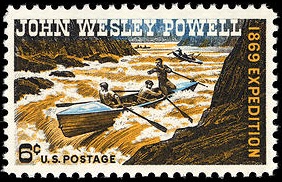I am quite impressed with the Grand Canyon. I know I’m not
the only one. All that rugged grandeur! The colors, the changing weather, the varying
landscape as you descend. The silence, as if all of nature is holding its breath.
But when John Wesley Powell decided to explore the Colorado River, through the
Grand Canyon, the place was not much more than a legend.
 So was he, truth be told. John Wesley Powell joined the
Union Army as a military engineer, but he served in many positions during the
Civil War and ended up a brevet lieutenant colonel. A minié ball blew off most of
his right arm, but he continued serving until the war ended. Geology was always
his greatest love, so he took a position as a professor at Illinois Wesleyan
University in that subject. He’d led his wife and students on several journeys
of exploration when he decided to tackle the Green and Colorado Rivers in 1869.
And he nearly lost his life in the process.
So was he, truth be told. John Wesley Powell joined the
Union Army as a military engineer, but he served in many positions during the
Civil War and ended up a brevet lieutenant colonel. A minié ball blew off most of
his right arm, but he continued serving until the war ended. Geology was always
his greatest love, so he took a position as a professor at Illinois Wesleyan
University in that subject. He’d led his wife and students on several journeys
of exploration when he decided to tackle the Green and Colorado Rivers in 1869.
And he nearly lost his life in the process.
Dangerous rapids, difficult portages, poor weather and flash
flood would all plague the trip. They lost most of their boats; they lost most
of their supplies. Three men gave up at one point to leave the expedition and
hike out of the canyon. They were never heard from again. Four months later, the
rest of the expedition made it out.
But the canyon had a grip on his heart and mind. Determined
to make it all the way through, with photographic evidence this time, he set
out again in May of 1871 with a group of hand-picked men, including
photographer John Hillers. It took them eight months, but they managed to
traverse the canyon safely, coming out at Kanab Creek. With photographs to
prove it.



Powell went on to publish his report of both trips for public
consumption, which went a long way toward instilling in the Nation a love for
the area, ensuring its preservation as a national park.
His first expedition was commemorated 100 years later with a
U.S. postal stamp.

Rather grand, isn’t it?






















